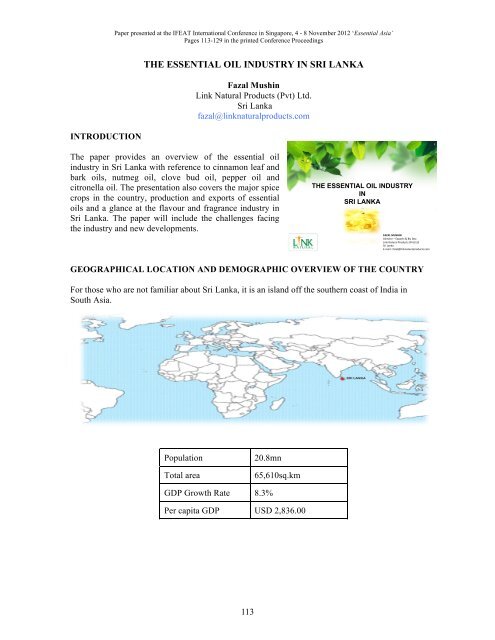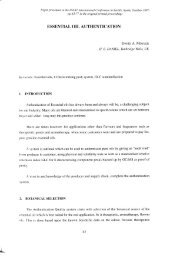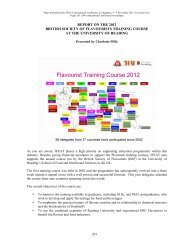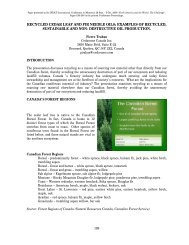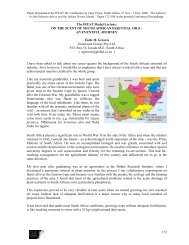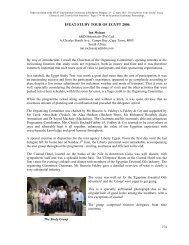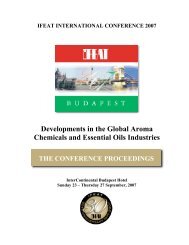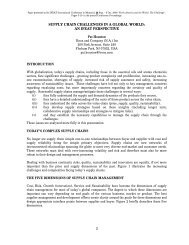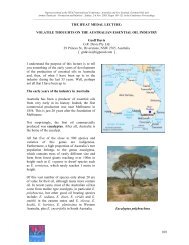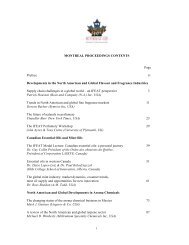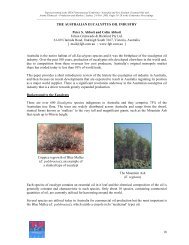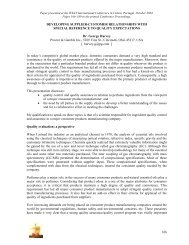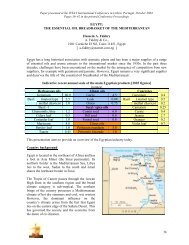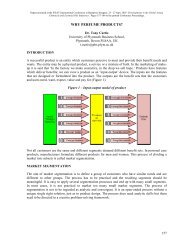THE ESSENTIAL OIL INDUSTRY IN SRI LANKA - IFEAT
THE ESSENTIAL OIL INDUSTRY IN SRI LANKA - IFEAT
THE ESSENTIAL OIL INDUSTRY IN SRI LANKA - IFEAT
Create successful ePaper yourself
Turn your PDF publications into a flip-book with our unique Google optimized e-Paper software.
!<br />
!<br />
!<br />
!<br />
!<br />
!<br />
!<br />
!<br />
!<br />
!<br />
!<br />
Paper presented at the <strong>IFEAT</strong> International Conference in Singapore, 4 - 8 November 2012 ‘Essential Asia’<br />
Pages 113-129 in the printed Conference Proceedings<br />
<strong>THE</strong> <strong>ESSENTIAL</strong> <strong>OIL</strong> <strong><strong>IN</strong>DUSTRY</strong> <strong>IN</strong> <strong>SRI</strong> <strong>LANKA</strong><br />
Fazal Mushin<br />
Link Natural Products (Pvt) Ltd.<br />
Sri Lanka<br />
fazal@linknaturalproducts.com<br />
<strong>IN</strong>TRODUCTION<br />
1<br />
The paper provides an overview of the essential oil<br />
industry in Sri Lanka with reference to cinnamon leaf and<br />
bark oils, nutmeg oil, clove bud oil, pepper oil and<br />
citronella oil. The presentation also covers the major spice<br />
crops in the country, production and exports of essential<br />
oils and a glance at the flavour and fragrance industry in<br />
Sri Lanka. The paper will include the challenges facing<br />
the industry and new developments.<br />
<strong>THE</strong> <strong>ESSENTIAL</strong> <strong>OIL</strong> <strong><strong>IN</strong>DUSTRY</strong><br />
<strong>IN</strong><br />
<strong>SRI</strong> <strong>LANKA</strong><br />
!!!!!!!!!!!!!!!!<br />
!<br />
!!!!!!!!!!!!!!!!!FAZAL%MUSH<strong>IN</strong>%%<br />
!!!!!!!!!!!!!!!!!Director!–!Exports!&!Biz!Dev.!<br />
!!!!!!!!!!!!!!!!!Link!Natural!Products!(Pvt)!Ltd!<br />
!!!!!!!!!!!!!!!!!Sri!Lanka!<br />
!!!!!!!!!!!!!!!!!Email!:!fazal@linknaturalproducts.com!<br />
GEOGRAPHICAL LOCATION AND DEMOGRAPHIC OVERVIEW OF <strong>THE</strong> COUNTRY<br />
For those who are not familiar about Sri Lanka, it is an island off the southern coast of India in<br />
South Asia.<br />
Population<br />
Total area<br />
20.8mn<br />
65,610sq.km<br />
GDP Growth Rate 8.3%<br />
Per capita GDP USD 2,836.00<br />
113
AGRICULTURAL SECTOR <strong>IN</strong> <strong>THE</strong> COUNTRY<br />
The agricultural sector in Sri Lanka is a major component of the<br />
economic and social development in the country with about 70% of<br />
its population connected to agriculture. Currently this sector<br />
contributes about 12% to GDP. Some 2.6 million people, or<br />
approximately 33% of the total labour force of 7.8 million, are<br />
directly employed in the agricultural sector. In the past, the Sri<br />
Lankan life style has been closely linked with agriculture, which has<br />
been a great influence on our culture and economy.<br />
When we look at the history of the agricultural activities, it goes back<br />
to 1st century B.C. when the then ruling kings engineered and built<br />
dams and waterways to irrigate the lands. These dams and waterways<br />
are still being used in present agricultural activities. Thereafter continued the colonial era of<br />
Portuguese, Dutch and finally the British. Historically Sri Lanka has been dependent on rice<br />
cultivation and after colonial rule of Sri Lanka for 400 years the agriculture land space was changed to<br />
mainly tea, rubber, coconut and coffee, which were the sort after crops for cultivation during that<br />
period. Before that, the people mainly cultivated paddy and other field crops, which were used for<br />
their day-to-day consumption. Since independence from Britain in 1948 the agricultural sector has<br />
continued to play a significant role in the Sri Lankan economy. Presently 42% of the country’s total<br />
area is under cultivation.<br />
Climatic changes have had an impact on agricultural productivity. Rain is a major component, which<br />
affects the crop output. For example, paddy is highly sensitive to rain and high temperature. Likewise<br />
other crops too are also depending on adequate rain and sunlight.<br />
Rain%fall%and%clima+c%zones%<br />
• Annual!average!rainfall!2,!027ml!<br />
• !!!!!Rainfall!seasons!in!Sri!Lanka!<br />
%%%%%%%%First%Intermonsoon!!!!!!!→!!!March%9%April%<br />
%%%%%%%%Southwest%Monsoon!!!!→!!!May%9%September%%%%<br />
%%%%%%%%Second%Intermonsoon%!→!!October%9%November%<br />
%%%%%%%%Northeast%Monsoon%%%%!→!!!December%9%February!<br />
Average%Rain%Fall%<br />
!<br />
Wet!Zone!!>!2500mm!<br />
!<br />
Intermediate!Zone!>!1900mm!!<br />
!<br />
Dry!Zone! 2,500mm<br />
Intermediate Zone > 1900mm<br />
Dry Zone < 1900mm<br />
114
!<br />
Clima&c(changes((<br />
(<br />
The graphs below provide a clear picture of the climatic changes during last three years, 2010 - 2012:<br />
!<br />
1. Rainfall (mm) 2. Temperature ( o C)<br />
1200!<br />
1000!<br />
800!<br />
600!<br />
400!<br />
200!<br />
0!<br />
!<br />
!<br />
!<br />
!!!!!!!!!!!!!!!!!!!!!!!!!!!!!!!!!!!!!!!!!!!!!!!!!!!!!!!!!!!!!!!!!!!!!!!!!!!!!!<br />
!<br />
3. Sunshine (Hrs)<br />
1.!!!!Annual!rain!fall!has!increased!!significantly!in!<br />
!!!!!!!2010.!<br />
10!<br />
!<br />
8!<br />
2. Average!!temperature!has!decreased!by!3!!!<br />
!Average!<br />
6!<br />
degrees!(Approx).!In!2012!this!remains!same!as!<br />
2010!<br />
4!<br />
!!!!!!!2011.!<br />
2011!<br />
2!<br />
2012!<br />
!<br />
0!<br />
3.!!!!Sunshine!remained!at!moderate!levels!during!<br />
!!!!!!!!past!5!years!without!change.<br />
JAN!<br />
JAN!<br />
FEB!<br />
!FEB!<br />
MAR!<br />
MAR!<br />
APR!<br />
APR!<br />
MAY!<br />
MAY!<br />
JUN!<br />
JUN!<br />
JUL!<br />
JUL!<br />
AUG!<br />
AUG!<br />
SEP!<br />
SEP!<br />
OCT!<br />
OCT!<br />
NOV!<br />
NOV!<br />
DEC!<br />
DEC!<br />
Average!<br />
2010!<br />
2011!<br />
2012!<br />
40.00!<br />
35.00!<br />
30.00!<br />
25.00!<br />
20.00!<br />
15.00!<br />
10.00!<br />
5.00!<br />
0.00!<br />
JAN!<br />
FEB!!<br />
MAR!<br />
APR!<br />
MAY!<br />
JUN!<br />
JUL!<br />
AUG!<br />
SEP!<br />
OCT!<br />
NOV!<br />
DEC!<br />
!Average!<br />
2010!<br />
2011!<br />
2012!<br />
7<br />
SPICE AGRICULTURAL CROPS <strong>IN</strong> <strong>SRI</strong> <strong>LANKA</strong><br />
Sri Lanka is well known for its spices since ancient<br />
times. Currently the export market for all spices is<br />
expected to reach US$ 1billion by 2020, which is<br />
an indication of the spice agricultural sector in Sri<br />
Lanka becoming a major source of foreign<br />
exchange generation.<br />
A significant proportion of the rural population in<br />
the upcountry districts of Sri Lanka rely on the<br />
export agricultural crops for their livelihood. All<br />
spice crops including clove, pepper, nutmeg,<br />
cardamom, cinnamon, ginger and turmeric are<br />
considered to be major export agricultural crops<br />
and make a considerable impact on the economy of<br />
the rural Sri Lanka.<br />
Agricultural*sector*.*2011*<br />
!<br />
• Total!land!under!cul-va-on!!!!!!!!!!!!!!!!!!!!!!:!!2,!645,000!ha!(42.2%)!<br />
• Agricultural!contribu-on!for!total!GDP!!!:!!11.2%!<br />
• Agricultural!crops!produc-on!<br />
!!!!!!!!Tea ! ! !Cinnamon!!!!!!!!!!!!!<br />
!!!!!!!!Rubber ! !Pepper!!!!!!!!!!!!!!!!!!<br />
!!!!!!!!Coconut ! !Clove!!!!!!!!!!!!!!!!!!!!!!<br />
!!!!!!!!Paddy ! !Cardamom!!!!!!!!!!!!<br />
!!!!!!!!!!!!!!!!!!!!!!!!!!!!!!!!!!!!!!!!!!!!!!!!!!!!!Nutmeg!&!Mace!!<br />
!<br />
8<br />
Small and medium scale farmers cultivate ginger and turmeric. Since these crops produce high yield<br />
and have higher demand, they are considered as high potential export agricultural crops.<br />
The government pays lot of attention to this sector and has specific line ministries over looking minor<br />
export crops and spices. And other institutions such as the Export Development Board also give<br />
assistance to the marketing of the spice industry. SAPPTA and the Spice Council are the other private<br />
sector organizations that are involve in this sector.<br />
115
<strong>ESSENTIAL</strong> <strong>OIL</strong>S PRODUCED <strong>IN</strong> <strong>SRI</strong> <strong>LANKA</strong><br />
Cinnamon Oil<br />
Cinnamon is the main spice crop of Sri Lanka. The cultivation of cinnamon is centred in the south<br />
western coastal area of the country. Total area under cultivation is about 30,523 hectares. Some 90%<br />
of true cinnamon is grown in Sri Lanka.<br />
Both cinnamon leaf and cinnamon bark oils are obtained by steam distillation.<br />
Crop production:<br />
18,250 mt<br />
Oil exports:<br />
Cinnamon leaf oil: 231mt<br />
Cinnamon bark oil: 8mt<br />
!<br />
Cinnamon!<br />
! !<br />
!!<br />
ProducDon!<br />
Whole!Spice!<br />
Main!ConsDtuents!<br />
Cinnamon!Leaf!!!Oil!<br />
•!!Total!extent!of!cinnamon!!!!!!!!!!!!!!!!!<br />
!!!!is!about!30,523ha.! • Eugenol!!!!!!!!!!!!!!!75%,85%!<br />
!<br />
•!!Total!cinnamon!!!<br />
!!!!producDon!!in!2011!was! Cinnamon!!Bark!!Oil!<br />
!!!!18,250mt.!<br />
!<br />
•!!!Cinamaldehyde!!55%,70%!<br />
•!!Total!export!volume!!is!!!!<br />
!!!13,515mt!(in!2011)!<br />
• Eugenol!!!!!!!!!!!!!!!!
Pepper Oil<br />
Pepper, which is known as the "king of spices", is widely grown in central upcountry and is now also<br />
being cultivated in the southeastern area too. The total area under the cultivation is 31,296 ha. Sri<br />
Lankan black pepper has a high level of piperine and volatile oil content.<br />
A fair amount of black pepper ends up with the distillers, as farmers tend to harvest the light berry<br />
pepper. Black pepper oil is produced by the steam distillation of the dried berries.<br />
13<br />
!Pepper%<br />
Produc;on!<br />
Main!Cons;tuents!<br />
Crop production:<br />
10,800 mt<br />
Oil exports: 8.5 mt<br />
!<br />
!<br />
Whole%Spice%<br />
•!!Total!extent!of!pepper!!<br />
!!!!is!about!31,296ha.!<br />
!<br />
!<br />
•!!Total!pepper!produc;on!!!<br />
!!!!in!2011!was!10,800mt.!<br />
!<br />
! •!!Total!export!volume!is!<br />
!!!!5,056.5mt!(in!2011.)!<br />
!<br />
! ! !<br />
! !<br />
!!<br />
!!!!!!!!!!!!!!!!!!!!!!!!!!!!!!!!!!!!!!!!!!!!!!!!!!!!!!!!!!!!!!!!!<br />
!!!!!<br />
Black%Pepper%Oil%<br />
• α!–!pinene!!!!!!!!!!!!!3.5%!–!10.0%!<br />
•!!ß!–!pinene!!!!!!!!!!!!!6.0%!–10.0%!<br />
•!!sabinene!!!!!!!!!!!!!!!6.0%!–!11.0%!<br />
•!!ß!I!caryphyllene!21.0%!–!35.0%!<br />
Source:(Department(of(Export(Agriculture(<br />
Specifications of<br />
Black Pepper Oil<br />
α – pinene (3.5-10.0%),<br />
β – pinene (6.0-10.0%)<br />
Major constituents sabinene (6.0-11.0%)<br />
β – caryphyllene<br />
(21.0-35.0%)<br />
Physical appearance<br />
Colourless to bluish<br />
green clear liquid<br />
Odour<br />
Fresh, dry-woody and<br />
warm-spicy reminiscent<br />
Specific gravity at 20 °C 0.868 to 0.890<br />
Optical rotation at 20 °C - 18 to + 4<br />
Refractive index at 20 °C 1.480 to 1.4920<br />
Country of<br />
origin<br />
Piperine<br />
content<br />
%<br />
Volatile oil<br />
content<br />
%<br />
Tellicherry 3.83 2.10<br />
Lampong 5.43 1.90<br />
Malabar 6.58 3.73<br />
Sri Lanka 8.91 3.97<br />
Madagascar 5.72 2.90<br />
Brazil 6.05 2.75<br />
Awak 7.20 2.79<br />
Muntok 6.10 2.32<br />
117
Clove Bud Oil<br />
Cloves are used in the form of whole cloves. The crop is mainly grown in the upcountry wet zone. The<br />
total extent of clove is 7,605 ha. Most of the cloves are exported, mainly to India. The eugenol acetate<br />
level is higher than other origins.<br />
Clove bud oil is produced by the steam or water distillation of the flower bud of the plant.<br />
14<br />
Clove&<br />
ProducAon!<br />
Main!ConsAtuents!<br />
Crop production: 5,553 mt<br />
Oil exports: 13 mt<br />
Whole&Spice&<br />
• Total!extent!of!clove!is!<br />
!!!!!!7,605ha.!<br />
!<br />
• !!!!Total!clove!producAon!!<br />
in!<br />
!!!!!!2011!was!!5,533mt.!<br />
!<br />
• !!!!Total!export!volume!is!<br />
!!!!!!5,195.4mt!(in!2011)!<br />
Clove&Oil&<br />
!<br />
•!eugenol!!!!!!!!!!!!!!!!75%+85%!<br />
•!eugenyl!acetate!!!!9%+16%!!<br />
Source:(Department(of(Export(Agriculture(<br />
Major constituents<br />
Physical appearance<br />
Odour<br />
Specifications of<br />
Clove Bud Oil<br />
eugenol (75-85%)<br />
eugenyl acetate (9-16%)<br />
Pale yellow clear liquid<br />
Warm, spicy and eugenolic<br />
Specific gravity at 20 °C 1.040 to 1.060<br />
Optical rotation at 20 °C -1.5 to 0<br />
Refractive index at 20 °C 1.5280 to 1.5370<br />
Nutmeg oil<br />
Nutmeg is mainly a home garden crop in the central wet zone of the Island. Nutmeg and mace are the<br />
main two products of this tree and both are mainly used for culinary purposes and other food products.<br />
The total extent of nutmeg is 954 ha. Although the land area is relatively small yields are relatively<br />
high. Most of the trees are 25 to 50 years old with high productivity. The nutmeg found in Sri Lanka is<br />
similar to that found in Grenada. Sri Lankan nutmegs are low in safrol and myristicin and at the same<br />
time high in sabinene, when compared to Indonesian variety. Nutmeg oil is produced by the steam<br />
distillation of the seeds of the plant.<br />
118
15<br />
Crop production: 2,700 mt<br />
Oil exports: 30 mt<br />
Nutmeg'and'Mace'<br />
!<br />
Produc9on!<br />
Whole'Spice'<br />
• !Total!extent!of!nutmeg!is!<br />
!!!954ha!<br />
!<br />
• !Total!nutmeg!produc9on!<br />
!!!in!2011!is!2,700mt!<br />
!!!(approx)!<br />
!<br />
• !Total!export!volume!is!<br />
!!!2,200mt!in!2011!(approx)!<br />
Main!Cons9tuents!<br />
Nutmeg'Oil'<br />
•!!α!–!pinene!!!!!13.5%!–!17.0%!<br />
•!!ß!–!pinene!!!!!!10.2%!–!11.0%!<br />
•!!sabinene!!!!!!!!!36.0%!–42.5%!<br />
•!!myris9cin!!!!!!!!!!!2.0%!–!2.7%!<br />
•!!safrol!!!!!!!!!!!!!!!!!!!0.5%!–!1.2%!<br />
Source:'Department.of.Export.Agriculture'<br />
Major constituents<br />
Physical appearance<br />
Odour<br />
Specific gravity at 20 °C 0.885 to 0.915<br />
Optical rotation at 20 °C + 8 to + 25<br />
Refractive index at 20 °C 1.4750 to 1.4880<br />
Specifications of<br />
Nutmeg Oil<br />
α – pinene (13.0-17.0%)<br />
β – pinene (10.2-11.0%)<br />
sabinene (36.0-42.5%)<br />
myristicin (2.0-2.7%)<br />
safrol (0.5-1.2%)<br />
Colourless to pale yellow clear liquid<br />
Terpiny, woody and spicy nutmeg<br />
Parameter West Indies East Indies Sri Lanka<br />
Composition α – pinene (10.6-<br />
13.2%)<br />
β – pinene (7.8-12.1%)<br />
sabinene (42.0-50.7%)<br />
myristicin (0.5-0.9%)<br />
safrol (0.1-0.2%)<br />
α – pinene (18.0-26.5%)<br />
β – pinene (9.7-17.7%)<br />
sabinene (15.4-36.3%)<br />
myristicin (3.3-13.5%)<br />
safrol (0.6-3.2%)<br />
α – pinene (13.0-17.0%)<br />
β – pinene (10.2-11.0%)<br />
sabinene (36.0-42.5%)<br />
myristicin (2.0-2.7%)<br />
safrol (0.5-1.2%)<br />
Relative density at 20 °C 0.860 to 0.880 0.885 to 0.915 0.885 to 0.915<br />
Optical rotation at 20 °C +25 to +45 +8 to +25 +8 to +25<br />
Refractive index at 20 °C 1.4720 to 1.4760 1.4750 to 1.4880 1.4750 to 1.4880<br />
Solubility in ethanol 90% (v/v) 1:4 1:3 1:3<br />
119
Citronella Oil<br />
The citronella plant is a 1-2 metres tall bush and cultivation has largely been spread in southern part of<br />
the country. Total extent of citronella is 1,174 ha. The geraniol content of Sri Lankan citronella oil is<br />
higher than Java citronella oil.<br />
Citronella oil is produced by the steam distillation of the leaves of the plant.<br />
16<br />
Oil production: 25 mt<br />
Oil exports: 11.7 mt<br />
Citronella*<br />
Produc7on!<br />
Whole*Spice*<br />
• !!Total!extent!of!<br />
!!!!citronella!is!1,174ha!<br />
!<br />
• !!Total!citronella!oil!<br />
!!!!produc7on!is!25mt!in!<br />
!!!!2011.!<br />
!<br />
• !!Total!export!volume!<br />
!!!!(citronella!oil)!is!<br />
!!!!11.7mt!in!2011!<br />
Main!Cons7tuents!<br />
Citronella*Oil*<br />
•!citronellal!!!34.8%D36.6%!!<br />
•!geraniol!!!!!!!22.1%D25.4%!!<br />
•!cirtonellol!!!!!9.9%D11.5%!<br />
Source:*Department.of.Export.Agriculture*<br />
Major constituents<br />
Physical appearance<br />
Odour<br />
Specifications of<br />
Citronella Oil<br />
Citronellol, geraniol, citronellal<br />
Golden yellow clear liquid<br />
Lemon like<br />
Specific gravity at 20 °C 0.900 – 0.910<br />
Optical rotation at 20 °C -6 to -14<br />
Refractive index at 20 °C 1.478 to 1.483<br />
Specifications Ceylon (C. nardus) Java (C. winterianus)<br />
Major constituents<br />
Citronellal (34.8-36.6%)<br />
geraniol (22.1-25.4%)<br />
cirtonellol (9.9-11.5%)<br />
Citronellal (13.3-14.7%)<br />
geraniol (17.5-40.0%)<br />
cirtonellol (6.2-6.5%)<br />
Physical appearance Pale yellow to brownish Yellow to pale brown<br />
Odour Lemon like Lemon like (more superior)<br />
Specific gravity at 20 °C 0.894 – 0.910 0.880 – 0.895<br />
Optical rotation at 20 °C -6 to -14 -6 to -14<br />
Refractive index at 20 °C 1.479 – 1.487 1.466 – 1.473<br />
Moisture content (%) 0.4 1.1<br />
120
Cardamom Oil<br />
Cardamom is cultivated as a mono crop in the Central hills and used mainly in the food industry, as a<br />
flavour, the dried fruit is the commodity of trade. The total extent of cardamom is 2,795 ha. The<br />
terpinal acetate level is higher in Sri Lankan cardamom oil when compared to other origins. There are<br />
good prospects for organic cardamom, production of which is expanding.<br />
Cardamom oil is produced by the steam distillation of the fruit of the plant.<br />
17<br />
Cardamom''<br />
Produc:on!<br />
Whole'Spice'<br />
Main!Cons:tuents!<br />
Cardamom'Oil'<br />
Crop production: 57 mt<br />
Oil exports: 1.5 mt<br />
!<br />
• !!!Total!extent!of!<br />
!!!!!cardamom!is!2,795ha.!<br />
!<br />
• !!!Total!cardamom.!!<br />
!!!!!produc:on!is!57mt!in!2011!<br />
!<br />
• !!!Total!export!volume!is!<br />
!!!!!1.5!mt!(oil)!in!2011!<br />
•!sabinene!!!!!!!!!!!!!!!!!!!4.26%!<br />
•!myrecene!!!!!!!!!!!!!!!!!2.08!%!<br />
• 1,8!Cineol!!!!!!!!!!!!!!!!29.39!%!<br />
•!linalool!!!!!!!!!!!!!!!!!!!!!4.04!%!<br />
•!terpinyle!acetate!!41.93!%!<br />
!<br />
Source:'Department.of.Export.Agriculture'<br />
Major constituents<br />
Specifications of<br />
Cardamom Oil<br />
sabinene 4.26%<br />
myrecene 2.08 %<br />
1,8 Cineol 29.39 %<br />
linalool 4.04 %<br />
terpinyle acetate 41.93 %<br />
121
DEVELOPMENT PROJECTS <strong>IN</strong> <strong>ESSENTIAL</strong> <strong>OIL</strong>S<br />
The growing demand in industrialised countries for natural products has created a wide market for<br />
essential oils. Therefore, the development of the essential oil industry is important since the country<br />
has the raw materials and appropriate climatic conditions for the initiation of crop cultivations. This<br />
will also result in increased foreign exchange revenues.<br />
The main distillers in the country have shown their interest in cultivating new plants such as coleus,<br />
sandalwood, ginger, and turmeric etc. Further they are moving ahead with producing organic certified<br />
essential oils and extracts since there is a growing demand for organic products in the market.<br />
18<br />
!<br />
!<br />
Poten&al)new)crops)<br />
Turmeric!<br />
Ginger!<br />
Davana!<br />
Ve3ver!<br />
!!!!!!!<br />
Coleus!!!!!!!!!!!!!!!!!!!!!!!!!!!!!!!!!!!!!!!!!!!!!!!!!!!!!Sandalwood!<br />
!<br />
!<br />
<strong>ESSENTIAL</strong> <strong>OIL</strong> SECTOR: STRUCTURE AND TRADE<br />
Structure<br />
It is apparent from the above discussion that there are seven major essential oils produced in Sri<br />
Lanka, namely cinnamon bark and leaf oils, nutmeg oil, clove bud oil, black pepper oil, citronella oil<br />
and cardamom oil.<br />
The complex supply chain network in the essential oil sector is illustrated in the following diagram.<br />
Since there are a large number of smallholders it is difficult to organise them into a continuous and<br />
steady supply chain that provides a regular supply of raw materials as well as controls the quality and<br />
sustainability of supply to keep the industry operating throughout the year. There are usually three of<br />
four levels of traders before the product ends up with the processor, exporter or consumer. The system<br />
has worked reasonably well for many hundred of years but the industry is trying to reduce the<br />
complexity of the supply chain in order to ensure the quality of the material coming into the factory.<br />
122
There are 4 main distillers in the country, as well as 12 other small/medium distilling companies and it<br />
is anticipated that this number will grew in the next 2-3 years. With regard to the number of field<br />
distillation units there are 135 field distillation units for cinnamon leaf oil and 30 field distillation units<br />
for citronella oil.<br />
The spice industry in Sri Lanka is a very old industry but during the last 30 or so years has made<br />
significant progress and the country has become better known for supplying a range of products other<br />
than cinnamon.<br />
Supply&chain&network&of&spice&crops&&<br />
19<br />
!!<br />
!<br />
!!<br />
!<br />
!<br />
!<br />
!<br />
!<br />
!<br />
!!<br />
!<br />
!<br />
Oil&<br />
Dis>llers&<br />
Export&<br />
Collectors&<br />
Wholesalers&<br />
Producers&<br />
Auc>ons&<br />
Exporters&<br />
Village&<br />
Traders&<br />
Town&<br />
Traders&<br />
Retailers&<br />
Consumers&<br />
Sri Lankan essential oil export volumes for the years 2009 to 2011 are shown in the table. The<br />
dominant export ! is cinnamon leaf oil, recent exports have shown wide annual fluctuations peaking at<br />
265.7 mt in 2010.<br />
! ! ! !!<br />
!Exports(of(essen,al(oils(! ! ! !!<br />
!<br />
Product(<br />
!<br />
!<br />
!<br />
!<br />
!<br />
!<br />
!<br />
!<br />
!<br />
Volume((mt)(in((<br />
2009(<br />
(<br />
Volume((mt)(in(<br />
2010(<br />
(<br />
Volume((mt)(in(<br />
2011(<br />
Cinnamon!leaf!oil! 107! 265.7! 231!<br />
Pepper!oil! 3.7! 5.9! 8.5!<br />
Nutmeg!oil! 15! 25! 30!<br />
Cardamom!oil! 0.2! 0.4! 1.5!<br />
Citronella!oil! 7! 9! 11.7!<br />
Cinnamon!bark!oil! 7! 7! 8!<br />
Clove!oil! 1.5! 10.7! 13!<br />
123<br />
23
This volume could be increased since only about 10% of the available leaf is used for oil extraction.<br />
Most leaf is used for fertiliser since the relatively low prices does not encourage the farmers to use it<br />
for oil production.<br />
Export of other oils are much smaller but have shown an upward trend in recent years. Thus, exports<br />
of pepper oil are growing and it is anticipated that this will continue with India being the dominant<br />
market. Nutmeg oil exports are growing; the crop is growing and has not suffered from any disease<br />
problems or low productivity. The export volume can definitely increase since there are 600 – 800 of<br />
nutmeg available and only about half of it is used for distillation. Cardamom oil exports are small but<br />
growing, especially organic oil, but Sri Lanka cannot compete with Guatemala with regard to<br />
conventional cardamom oil. Citronella oil exports are growing slowly but the major problem is the<br />
fluctuating prices, which make it difficult to induce farmers to grow the crop and produce the oil.<br />
Cinnamon bark oil is relatively stable but there has been a growing demand for the spice, especially<br />
from Latin America for culinary purposes. This is likely to grow further especially for organic oil.<br />
Exports of clove oil have been increasing recently and the dominant market is India.<br />
The export destination of the essential oils is illustrated in the following table, which shows the<br />
domination of the USA, EU and Indian markets. In recent years India has become a much more<br />
important market for Sri Lankan oils.<br />
!<br />
!Major&des*na*ons&of&essen*al&oils&–&2011&&&&&&&&&&&&&&&&&&&&&&&&&&&&&&&&&&&&&&<br />
!!!!!!!!!!!!!!!!!!!!!!!!!!!!!!!!!!!!!!!!!!!!!!!!!!!!!!!!!!!!!!!!!<br />
Cinnamon!leaf!<br />
oil!<br />
USA&<br />
%&<br />
UK&<br />
%&<br />
France&<br />
%&<br />
India&<br />
%&<br />
Germany&<br />
%&<br />
Others&<br />
%&<br />
57! 8! 4! 12! 2! 17!<br />
Pepper!oil! 13! 1! 1! 84! 1! 0!<br />
Nutmeg!oil!<br />
52! 12! 3! 3! 16! 13!<br />
24<br />
Citronella!oil!<br />
46! 3! 17! 0! 6! 27!<br />
Cinnamon!<br />
bark!oil!<br />
12! 4! 16! 0! 63! 4!<br />
Clove!oil! 47! 2! 3! 39! 5! 6!<br />
124
MAJOR CHALLENGES <strong>IN</strong> <strong>THE</strong> <strong><strong>IN</strong>DUSTRY</strong><br />
Though the industry – both the government and the private sectors - have initiated many development<br />
programmes there are still many constraints to be overcome if Sri Lanka is to be competitive in the<br />
market. Some of the limitation factors associated with the essential oil industry include:<br />
• Instability of market prices which has an undesirable impact on both the farmers and the<br />
processors<br />
• Lack of long term backward integration for new cultivation<br />
• Establishing effective supply chain<br />
• Lack of initiatives for moving up the value chain; need to move beyond essential oils<br />
• Environmental/climate changes affecting everyone globally and we have to deal with them<br />
when they occur.<br />
DEVELOPMENT PROJECTS <strong>IN</strong> <strong>THE</strong> <strong><strong>IN</strong>DUSTRY</strong><br />
Sri Lanka offers very good opportunities for the expansion of the organic essential oil business as well<br />
as various added value products. The smallholder families use very little fertiliser; there is very little<br />
pollution; the industrial base is not that large; the underground water streams are not contaminated, so<br />
there is negligible pesticides or heavy metal pollution. So organic essential oils is a niche market area<br />
which is growing and in which Sri Lanka can compete. In addition, investments are taking place to<br />
develop new products including fractions, isolates and CO2 processing – both conventional and<br />
organic.<br />
Companies also realise that they must integrate backwards in order to ensure raw material supplies.<br />
Companies are developing new plantations for new crops and expanding the existing cultivation area,<br />
including working with existing plantation companies to encourage them to plant spices alongside<br />
their traditional plantation crop production. Also they are trying to collectivise smallholders as well as<br />
organising buy-back schemes. The end of the civil war has led to the opening up of the northern and<br />
eastern parts of the country and is offering new opportunities to develop new areas of production.<br />
Donor agencies are also assisting in the development of lands, which are now free.<br />
<strong>IN</strong>STITUTIONAL SUPPORT<br />
Within the country there are a number of institutions that support the spice and essential oil sector. The<br />
Sri Lanka Export Development Board, which is the apex body, drives the marketing, value addition<br />
and promotion of the industry. It has supported the attendance of a few companies to the <strong>IFEAT</strong><br />
Singapore Conference to expose them to the international industry. The government places a lot of<br />
emphasis on the minor crops and there are two ministries involved, namely the Department of<br />
Agriculture and the Department of Export Agriculture, which overlook spices. This reflects the<br />
importance of spices to the development of the rural economy.<br />
In addition, there are two private sector trade associations working alongside the government in<br />
helping to promote the industry, namely the Spice Council and The Spices and Allied Products<br />
Producers’ and Traders’ Association.<br />
125
28<br />
Ins$tu$onal*support*<br />
The$Apex$Body$<br />
!<br />
Others$<br />
Department!of!Agriculture!<br />
Department!of!Export!Agriculture!<br />
Trade$Associa3on$<br />
!!The!Spices!!and!Allied!Products!<br />
!!Producers’!and!Traders’!Associa;on!<br />
The!Spice!Council!<br />
Within the essential oils sector there are four main well-established companies, each of which has<br />
been an <strong>IFEAT</strong> member for at least 20 years or more, namely:<br />
HD de Silva Group<br />
EOAS Organics<br />
LB Spices Trading (Pvt.) Ltd<br />
Link Natural Products (Pvt.) Ltd.<br />
This number will grow as other companies develop and will show a similar level of sophistication<br />
rather than just a cottage industry.<br />
<strong>IFEAT</strong>&members&<br />
27<br />
!<br />
!!<br />
HD!De!Silva!Group!!<br />
EOAS!Organics<br />
!<br />
!<br />
!<br />
LB!Spices!Trading!(Pvt)!Ltd!!<br />
Link!Natural!Products!(Pvt)!Ltd!<br />
126
<strong>THE</strong> FLAVOUR AND FRAGRANCE <strong><strong>IN</strong>DUSTRY</strong> <strong>IN</strong> <strong>SRI</strong> <strong>LANKA</strong><br />
The flavours and fragrance sectors in Sri Lanka have been growing quickly, thanks to rising incomes,<br />
the cessation of the civil war and the opening up new markets in the north and eastern regions,<br />
changing social and cultural habits, as well as the growth of tourism. Both the food manufacturing and<br />
beverage industries have shown tremendous growth.<br />
Flavours and fragrances are used as ingredients for the food industry. Fragrances are also used in the<br />
personal care industry and the household care industry. These raw materials might be of natural origin<br />
like essential oils, which have been discussed earlier, or a composition of synthetic chemicals. Orange,<br />
lemon, and lime are the widely used flavours and rose, jasmine are the fragrances that are moving<br />
quickly in the market.<br />
Tea, carbonated beverages, nutritional drinks, RTS (ready to serve) and concentrated juices, alcohol,<br />
confectionaries, cosmetics, detergents and toiletry are the industries which are using considerable<br />
amounts of flavours and fragrances. The total trade value of above markets is US$ 1,284 million<br />
during the last year. The value of flavours and fragrances imported during last year was US$ 25.68<br />
million (HS Codes: 3302.10.10; 3302.10.20; 3302. 10.90; 3302.90.00 and Others). The value is<br />
probably higher because ingredients may be included in other code numbers.<br />
In 2011, there was an 8.7% growth in the food manufacturing industry compared to 2010. Expanding<br />
the FMCG sector to Northern and Eastern provinces was a major factor behind this growth. The<br />
beverage manufacturing industry saw a 10.2% growth in 2011 compared to 2010. A key factor was the<br />
growth of the tourism sector. The value of consumption in various beverage sectors is illustrated in the<br />
slide.<br />
The total market value of the industries that use flavours and fragrances are listed below.<br />
32<br />
Consump(on)of)flavours)and)fragrances)<br />
• !Tea!(Flavoured!Tea,!Green!Tea,!Black!Tea) ! !US$.!!!!!12!mn!!!Ceylon'Tea'Board'<br />
• !Carbonated!Beverages! ! ! ! !US$.!!!130!mn!!!!Nielsen'<br />
• !NutriDonal!Drinks! ! ! ! !US$.!!!!!20!!mn!!!!!!,,!<br />
• !RTS!&!Concentrated!Juice ! ! !US$.!!!!!!10!mn!!!!!!,,!<br />
• !Alcohol! ! ! ! ! !US$.!!!!440!mn!!!!Excise'Dpt.'<br />
!<br />
• ConfecDonery ! ! ! ! !US$!!!360!mn!<br />
• CosmeDcs ) ))))) ) ) )US$!!!192!mn!<br />
• Detergents!&!Toiletry)))))))) ) ) )US$!!!120!mn!!<br />
127
There is an increasing number of key international F&F companies represented in Sri Lanka and they<br />
are servicing the F&F industry.<br />
Key$interna*onal$players$represented$in$Sri$Lanka$<br />
31<br />
• IFF$<br />
• Robertet$<br />
• Firmenich$<br />
• Takasago$<br />
• Givaudan$<br />
• Symrise$<br />
!<br />
Thank you for your attention – and I look forward to welcoming you to Sri Lanka for a future<br />
international conference.<br />
128
THANK YOU<br />
!<br />
!<br />
!<br />
!<br />
!<br />
!<br />
!<br />
!<br />
!<br />
!!!!!!!!!!!!!!!!<br />
!<br />
!!!!!!!!!!!!!!!!!!!FAZAL%MUSH<strong>IN</strong>%%<br />
!!!!!!!!!!!!!!!!!Director!–!E!&!BD!<br />
!!!!!!!!!!!!!!!!!Link!Natural!Products!(Pvt)!Ltd!<br />
!!!!!!!!!!!!!!!!!Sri!Lanka!<br />
!!!!!!!!!!!!!!!!!E;mail!:!fazal@linknaturalproducts.com!<br />
!<br />
!<br />
Fazal Mushin is the Director of Exports & Business Development at Link<br />
Natural Products (Pvt) Ltd., Sri Lanka. He joined Link Natural in 2003,<br />
overlooking the purchasing of raw material and exports of Essential Oils. Link<br />
Natural Products, has been in the essential oil business since 1982. He has<br />
actively been involved with several trade chambers representing exports and<br />
spices. He has also headed the organising of the <strong>IFEAT</strong> Study Tour in 2005.<br />
With over 29 years of working experience in trading of commodities, of which<br />
the last 16 years in spices and thereafter, essential oils. In Sri Lanka,<br />
smallholder families cultivate 70% of spices and thus, collectivising and establishing a sound supply<br />
chain, whilst understanding the global demand and trends is vital to our business, including the<br />
impact of environmental changes.<br />
129


